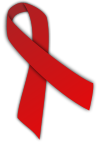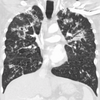Video:HIV-AIDS
| HIV-AIDS (Tutorial) | |
|---|---|
| On Commons | |
| Steps for video creation | |
| Step 1 | Preview my changes (10 sec) |
| Step 2 | Upload to Commons (10 min) |
Definition
Human immunodeficiency virus infection (or HIV), and acquired immune deficiency syndrome (or AIDS), is a spectrum of conditions caused by infection with the human immunodeficiency virus.[1][2][3]

Initial symptoms
Following the initial infection, a person may not notice any symptoms, or may experience a brief period of flu-like illness.[4] This is followed by a prolonged period with no symptoms.[5]

Late symtpoms
As the infection progresses, it interferes more with the immune system, increasing the risk of developing common infections such as tuberculosis, as well as other opportunistic infections, and tumors that rarely affect people who have uncompromised immune systems.[4]

Symptoms of AIDS
These late symptoms of infection, are referred to as acquired immunodeficiency syndrome (or AIDS).[5] This stage is also associated with unintended weight loss.[5]

Transmission
HIV is spread primarily by unprotected sex (including anal, and oral sex), contaminated blood transfusions, and hypodermic needles. It can also be spread from mother to child during pregnancy, delivery, or breastfeeding.[6] Some bodily fluids, such as saliva and tears, do not transmit HIV.[7]

Prevention
Methods of prevention include safe sex, needle exchange programs, treating those who are infected, pre, and post exposure prophylaxis, and male circumcision.[4]

Mother-child prevention
The spread of HIV from mother to child, during childbirth, can be prevented by giving both of them antiretroviral medication.[4]

Treatment
There is no cure or vaccine; however, antiretroviral treatment can slow the course of the disease, and may lead to a near-normal life expectancy.[5][8]

Effect of treatment
Treatment is recommended as soon as the diagnosis is made.[9] Without treatment, the average survival time after infection is 11 years.[10]

Epidemiology
In 2016, about 36.7 million people were living with HIV, and it resulted in 1 million deaths.[11] There were 300,000 fewer new HIV cases in 2016 than in 2015.[12] Most of those infected, live in sub-Saharan Africa.[4]

Initial outbreak
From the time AIDS was identified in the early 1980s, to 2017, the disease has caused an estimated 35 million deaths worldwide.[13]

Current status
HIV AIDS is considered a pandemic, because it is a disease outbreak which is present over a large area, and is actively spreading.[14]

History
HIV originated in west-central Africa during the late 19th, or early 20th century during colonialism.[15]

Outbreak in North America
AIDS was first recognized by the United States Centers for Disease Control and Prevention in 1981, and the HIV virus was identified as its cause shortly after.[16]

Societal effects
HIV-AIDS has had a large impact on society, both as an illness and as a source of discrimination.[17]

Economic impact
The disease also has large economic impacts.[17] There are many misconceptions about HIV-AIDS, such as the belief that it can be transmitted by casual, non-sexual contact.[18]

Religious effect
The disease has become subject to many controversies involving religion, including the Catholic Church's position not to support condom use as prevention.[19]

Funding
Despite this, HIV-AIDS has attracted international medical and political attention, as well as large-scale funding since it was identified in the 1980s.[20]

References
- ↑ Sepkowitz KA (June 2001). "AIDS – the first 20 years". The New England Journal of Medicine. 344 (23): 1764–72. doi:10.1056/NEJM200106073442306. PMID 11396444.
- ↑ Krämer A, Kretzschmar M, Krickeberg K (2010). Modern infectious disease epidemiology concepts, methods, mathematical models, and public health (Online-Ausg. ed.). New York: Springer. p. 88. ISBN 978-0-387-93835-6.
- ↑ Kirch W (2008). Encyclopedia of Public Health. New York: Springer. pp. 676–77. ISBN 978-1-4020-5613-0.
- ↑ 4.0 4.1 4.2 4.3 4.4 "HIV/AIDS Fact sheet N°360". WHO. November 2015. Archived from the original on February 17, 2016. Retrieved February 11, 2016.
- ↑ 5.0 5.1 5.2 5.3 "About HIV/AIDS". CDC. December 6, 2015. Retrieved February 11, 2016.
- ↑ Rom WN, Markowitz SB, eds. (2007). Environmental and occupational medicine (4th ed.). Philadelphia: Wolters Kluwer/Lippincott Williams & Wilkins. p. 745. ISBN 978-0-7817-6299-1.
- ↑ "HIV and Its Transmission". Centers for Disease Control and Prevention. 2003. Archived from the original on February 4, 2005. Retrieved May 23, 2006.
- ↑ UNAIDS (May 18, 2012). "The quest for an HIV vaccine". Archived from the original on May 24, 2012.
- ↑ Guideline on when to start antiretroviral therapy and on pre-exposure prophylaxis for HIV (PDF). WHO. 2015. p. 13. ISBN 978-92-4-150956-5. Archived (PDF) from the original on October 14, 2015.
- ↑ UNAIDS, WHO (December 2007). "2007 AIDS epidemic update" (PDF). Archived from the original (PDF) on May 27, 2008. Retrieved March 12, 2008.
- ↑ "Fact sheet – Latest statistics on the status of the AIDS epidemic | UNAIDS". www.unaids.org. Archived from the original on July 13, 2017. Retrieved July 21, 2017.
- ↑ "Global HIV and AIDS statistics". AVERT. 2015-07-16. Retrieved 2017-10-07.
- ↑ "Fact sheet – Latest statistics on the status of the AIDS epidemic". www.unaids.org. UNAIDS. Retrieved 2018-03-16.
- ↑ Kallings LO (March 2008). "The first postmodern pandemic: 25 years of HIV/ AIDS". Journal of Internal Medicine. 263 (3): 218–43. doi:10.1111/j.1365-2796.2007.01910.x. PMID 18205765.(subscription required)
- ↑ Sharp PM, Hahn BH (September 2011). "Origins of HIV and the AIDS pandemic". Cold Spring Harbor Perspectives in Medicine. 1 (1): a006841. doi:10.1101/cshperspect.a006841. PMC 3234451. PMID 22229120.
- ↑ Gallo RC (October 2006). "A reflection on HIV/AIDS research after 25 years". Retrovirology. 3 (1): 72. doi:10.1186/1742-4690-3-72. PMC 1629027. PMID 17054781.
- ↑ 17.0 17.1 "The impact of AIDS on people and societies". 2006 Report on the global AIDS epidemic. UNAIDS. 2006. ISBN 978-92-9173-479-5.
{{cite book}}: Unknown parameter|chapterurl=ignored (help) - ↑ Endersby, Jim (2016). "Myth Busters". Science. 351 (6268): 35. Bibcode:2016Sci...351...35E. doi:10.1126/science.aad2891. Archived from the original on February 22, 2016. Retrieved February 14, 2016.
- ↑ McCullom, Rob (February 26, 2013). "An African Pope Won't Change the Vatican's Views on Condoms and AIDS". The Atlantic. Archived from the original on March 8, 2016. Retrieved February 14, 2016.
- ↑ Harden, Victoria Angela (2012). AIDS at 30: A History. Potomac Books Inc. p. 324. ISBN 978-1-59797-294-9.